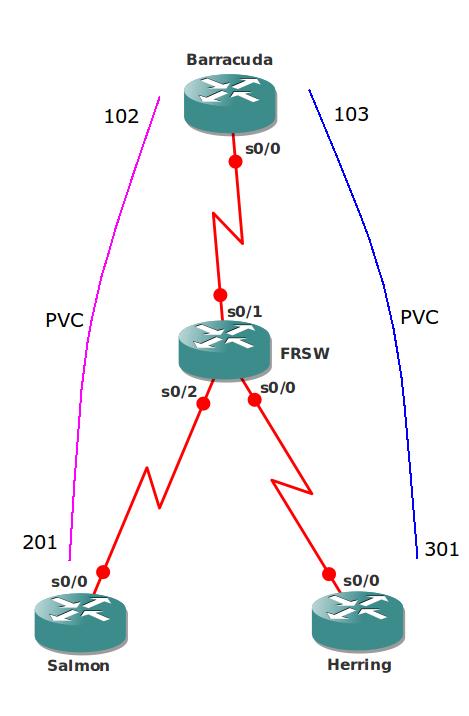Scenario:
As the senior network engineer for a Dutch fishing company you are responsible for connecting all the different branch offices to the main network. The WAN technology you are using is Frame Relay, and you need to run OSPF over this WAN connection. You are able to broadcast on this Frame Relay link.
Goal:
- The frame-relay switch has been preconfigured for you, as you can see in the topology picture the following PVC’s has been configured:
Router Barracuda to Salmon:
Barracuda: DLCI 102
Salmon: DLCI 201Router Barracuda to Herring:
Barracuda: DLCI 103
Salmon: DLCI 301
- Router Barracuda is the “Hub” router and the other 2 routers are the “Spoke” routers.
- Do not change any configuration on the Frame-Relay switch.
- Configure the following IP addresses:
Router Barracuda:
S0/0: 192.168.123.1 /24
L0: 1.1.1.1 /24Router Salmon:
S0/0: 192.168.123.2 /24
L0: 2.2.2.2 /24Router Herring:
S0/0: 192.168.123.3 /24
L0: 3.3.3.3 /24 - Configure all serial interfaces for encapsulation Frame-Relay.
- Disable Frame-relay inverse arp on all serial interfaces.
- Configure the correct frame-relay map statements on all routers and make sure you can ping every IP address.
- Configure the OSPF network type to “broadcast” on all serial interfaces.
- Configure OSPF on all 3 routers, make sure you have full connectivity. All IP addresses including the loopbacks should be reachable.
- You are not allowed to use the “neighbor” command in the OSPF configuration.
- Make sure router Salmon and Herring can never be the Designated or Backup designated router.
It took me 1000s of hours reading books and doing labs, making mistakes over and over again until I mastered all the protocols for CCNP.
Would you like to be a master of networking too? In a short time without having to read 900 page books or google the answers to your questions and browsing through forums?
I collected all my knowledge and created a single ebook for you that has everything you need to know to become a master of CCNP.
You will learn all the secrets about OSPF network types, frame-relay settings and more.
Does this sound interesting to you? Take a look here and let me show you how to Master CCNP ROUTE!
IOS:
c3640-jk9s-mz.124-16.bin
Topology:

Video Solution:
Configuration Files
You need to register to download the GNS3 topology file. (Registration is free!)Once you are logged in you will find the configuration files right here.

The How to Master series helps you to understand complex topics like spanning-tree, VLANs, trunks, OSPF, EIGRP, BGP and more.
Written by René Molenaar - CCIE #41726


Is it just me or are the final configs the same as the originals?
I messed up with uploading…i’ll fix them as soon as i can 😉
Hi Renee. Need your help again.
You are not allowed to use the "neighbor" command in the OSPF configuration.
how do we do that ? As far as i know neighbors should be configured manually on NBMA network. Or is there any other way as well to do it?
thanks
OSPF has 5 network types:
broadcast
non-broadcast
point-to-multipoint
point-to-multipoint non-broadcast
point-to-point
Some of them automatically try to find neighbors…up to you to find out which one(s) 🙂
This is what i understand.
with frame-relay inverse-arp on
broadcast (auto find neighbours)
non-broadcast
point-to-multipoint (auto find neighbours)
point-to-multipoint non-broadcast
point-to-point (auto find neighbours)
Rene,
Can you help me with an explanation on how to load your config files into GNS3?
Thanks
Leo
Hi Leo,
You were able to run the topology file? Or do you just want to import the router configs?
Rene
Labs are very helpful.
Thanks to you.
i don’t know how to download the ios image anyone to help me please…or give me tut on that please